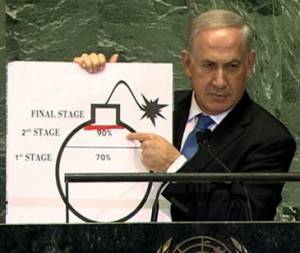According to former top advisers to George W. Bush and Barak Obama, the United States will preventively strike Iran in 2013 if no diplomatic settlement is reached over its nuclear program. From the Times of Israel:
During an on-stage discussion with Dennis Ross and Elliott Abrams halfway through the [...]]]>
 According to former top advisers to George W. Bush and Barak Obama, the United States will preventively strike Iran in 2013 if no diplomatic settlement is reached over its nuclear program. From the Times of Israel:
According to former top advisers to George W. Bush and Barak Obama, the United States will preventively strike Iran in 2013 if no diplomatic settlement is reached over its nuclear program. From the Times of Israel:
During an on-stage discussion with Dennis Ross and Elliott Abrams halfway through the evening, Washington Institute director Robert Satloff asked the former officials, “Will either America or Israel employ preventive military action against Iran’s nuclear program – yes or no?”
The two replied in unison, “yes.”
“Will this happen in 2013?” Satloff pressed.
“Yes,” said Ross.
“Yes, I agree,” added Abrams.
Last week the International Atomic Energy Association (IAEA) said Iran could be referred to the United Nations Security Council if it had “not begun substantive cooperation with the IAEA” by March 2013. This caused Micah Zenko to speculate about a deadline for a US attack, while others suggested the path is simply being prepared for another resolution.
Some well-informed Iran watchers are saying that Ross and Abrams’ prediction is on par with that of White House insiders. Whether that’s true or not, it’s undeniable that pressure will be very high on Obama to ‘do more’ if no headway is made with Iran in the next 6 months.
But according to Zenko, deadlines, while helpful on the pressure-front, can also be detrimental:
]]>Setting a March deadline provides some certainty and perhaps coercive leverage to compel Iran to cooperate with the IAEA. But declaring deadlines also places U.S. “credibility” on the line, generating momentum to use force even if there is no new actionable intelligence that Iran has decided to pursue a nuclear weapon. Based on what we know right now, that would be a strategic miscalculation.
According to Micah Zenko, the International Atomic Energy Association’s (IAEA) and Hillary Clinton’s recent endorsement of a March deadline for Iran nuclear talks is a pressure tactic resulting from exasperation over the lack of progress thus far. (His focus on US reasoning gives more weight to the claim that the [...]]]>
 According to Micah Zenko, the International Atomic Energy Association’s (IAEA) and Hillary Clinton’s recent endorsement of a March deadline for Iran nuclear talks is a pressure tactic resulting from exasperation over the lack of progress thus far. (His focus on US reasoning gives more weight to the claim that the IAEA is heavily influenced by the US.) But Zenko doesn’t point out that March 2013 had also been established as a key month by Israeli Prime Minister Bibi Netanyahu back in September.
According to Micah Zenko, the International Atomic Energy Association’s (IAEA) and Hillary Clinton’s recent endorsement of a March deadline for Iran nuclear talks is a pressure tactic resulting from exasperation over the lack of progress thus far. (His focus on US reasoning gives more weight to the claim that the IAEA is heavily influenced by the US.) But Zenko doesn’t point out that March 2013 had also been established as a key month by Israeli Prime Minister Bibi Netanyahu back in September.
During his speech at this year’s UN Annual General Assembly, Netanyahu used a much-ridiculed cartoon graphic to show that Iran could complete the second to last stage of uranium enrichment required to create a bomb by the Spring or Summer of 2013:
Where’s Iran? Iran’s completed the first stage. It took them many years, but they completed it and they’re 70% of the way there. Now they are well into the second stage. By next spring, at most by next summer at current enrichment rates, they will have finished the medium enrichment and move on to the final stage. From there, it’s only a few months, possibly a few weeks before they get enough enriched uranium for the first bomb.
He concluded that Iran could be stopped if a “credible” “red line” was set. Netanyahu’s assessment was critiqued by the non-proliferation focused Arms Control Association, among others, as “overly alarmist“. And until now, the US has defied Israeli pressure to set their line according to Israel’s, so what’s with this March deadline? Zenko’s analysis:
The answer depends greatly on whether the timeline to attack Iran is based on Israel’s national interest and its military capabilities, or those of the United States. Israeli officials have stated at various times that redlines should be “clear” (without providing clarity) and that they “should be made, but not publicly.” One also said, “I don’t want to set redlines or deadlines for myself.” Since November 2011, Israeli officials have also warned about a “zone of immunity,” which Barak has described as “not where the Iranians decide to break out of the non-proliferation treaty and move toward a nuclear device or weapon, but at the place where the dispersal, protection and survivability efforts will cross a point that would make a physical strike impractical.”
It is unclear how dispersed, protected, or survivable Iran’s nuclear program would have to be, but Secretary Clinton’s warning of “components…on a shelf somewhere” could indicate that the Obama administration is moving toward the zone of immunity logic. But what are these components, how many would be required to assume “weaponization,” and how would this new intelligence be presented as a justification for war? In addition, it is tough to make the case for going to war with Iran because it refused to concentrate its nuclear sites (that are under IAEA safeguards) in above-ground facilities that can be easily bombed.
Previously, U.S. officials have been less eager than the Israelis to define a specific redline, largely because the two countries have different perceptions of the Iranian threat and vastly different military capabilities. Setting a March deadline provides some certainty and perhaps coercive leverage to compel Iran to cooperate with the IAEA. But declaring deadlines also places U.S. “credibility” on the line, generating momentum to use force even if there is no new actionable intelligence that Iran has decided to pursue a nuclear weapon. Based on what we know right now, that would be a strategic miscalculation.
Some analysts are meanwhile suggesting that Zenko is completely off the mark. Mark Fitzpatrick, director of the non-proliferation and disarmament program at the international Institute for Security Studies, called Zenko’s analysis “alarmist” today on Twitter: ”With respect, you are wrong about the meaning of the March deadline for #iran to answer IAEA Qs. It only means new Resolution,” he said.
“If anyone else had written an alarmist claim the US set a March deadline for war, @MicahZenko would have roasted it,” said Fitzpatrick.
The Washington Post‘s Greg Miller has begun a three-part series on the future of the Obama Administration’s counterterrorism drone strike program, which will include a “next-generation targeting list” (aka “kill list”) in the form of a “dipposition matrix”.
Though the White House, CIA, JSOC and ODNI declined comment requests, the article cites [...]]]>
The Washington Post‘s Greg Miller has begun a three-part series on the future of the Obama Administration’s counterterrorism drone strike program, which will include a “next-generation targeting list” (aka “kill list”) in the form of a “dipposition matrix”.
Though the White House, CIA, JSOC and ODNI declined comment requests, the article cites “dozens of current and former national security officials, intelligence analysts and others.”
Miller’s report somewhat contradicts the Obama Administration’s frequent assertions that al Qaeda is exhausted and on the run. The officials interviewed essentially offer a redux of the “War on Terror” methodology minus the renditions and speechifying. And, even while touting the success of the program, the Administration remains committed to “embedding” it in national security planning.
According to Miller, the program is meant to outlive the Obama Administration: “White House counterterrorism adviser John O. Brennan is seeking to codify the administration’s approach to generating capture/kill lists, part of a broader effort to guide future administrations through the counterterrorism processes that Obama has embraced.”
The expansion of the US’s drone fleet and African operations were also noted, as was the US’s overall growing reliance on unarmed drone surveillance, now over Libya, and according to the Post, Iran. Meanwhile, The Diplomat notes the US is looking to create a more autonomous drone force that is less dependent on operator-control to carry out missions.
Micah Zenko of the Council on Foreign Relations reflects on President Obama’s institutionalization of “extrajudicial killings” in comparison to his predecessor’s more careful approach:
]]>Having spoken with dozens of officials across both administrations, I am convinced that those serving under President Bush were actually much more conscious and thoughtful about the long-term implications of targeted killings than those serving under Obama. In part, this is because more Bush administration officials were affected by the U.S. Senate Select Committee investigation, led by Senator Frank Church, that implicated the United States in assassination plots against foreign leaders—including at least eight separate plans to kill Cuban president Fidel Castro—and President Ford’s Executive Order 11905: “No employee of the United States Government shall engage in, or conspire to engage in, political assassination.”